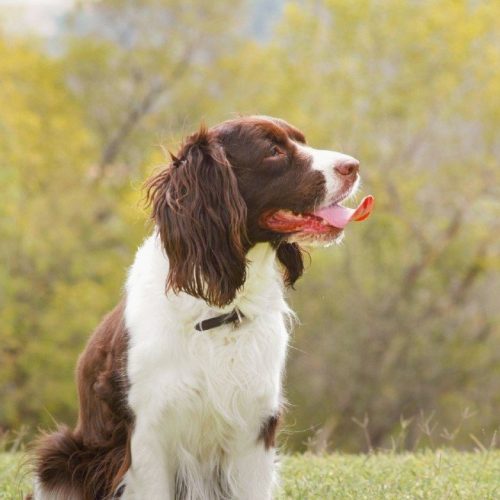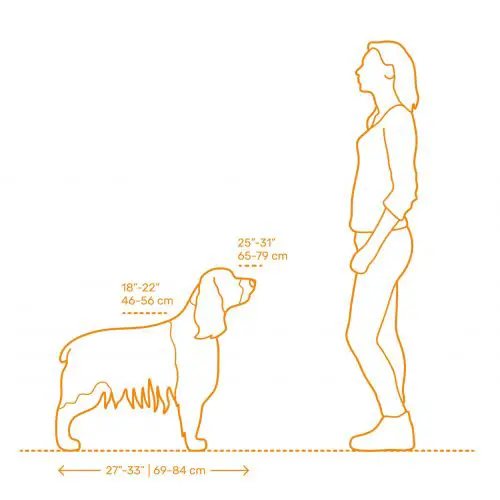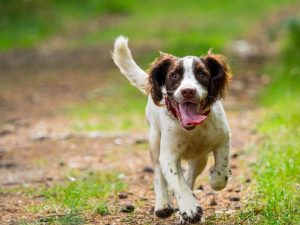
English Springer Spaniel Breed Profile
Popular as a hunting breed for centuries, these energetic dogs are lovable companions.
- High Energy
- 12-14 Years
- Intelligent
Springer Spaniel Profile
What's the Springer Spaniel's history and background?
The Springer Spaniel is an attentive companion dog that has a long working history in Europe. The original Spaniel breed made its way to England from Spain around 1570 to serve as hunting dogs. The litters of Spaniels often varied a great deal in size, the smaller dogs were used to hunt Woodcock birds and are now recognised as Cocker Spaniels.
The larger dogs of the litter were able to flush or ‘spring’ prey out from hiding spots, and this trait gave the Springer Spaniel its name, although it took until 1880 for the breed to be officially recognised as separate from its Cocker Spaniel cousins.
The longer legs of the Spingers help this breed claim the crown as the fastest of all Spaniels, when at full speed it uses its spine as a bow to release the legs into full extension in order to catch unsuspecting prey.
The breed has been a favourite among hunters in Europe for centuries and was used as a gun companion, with many of the original hunting traits still present in todays dogs. The excellent nose, intelligence, and soft bite allowed Spingers to retrieve downed prey without damaging them, and they have amazing energy and agility, giving them the ability to chase and retrieve prey all day long.
The Springer Spaniel comes in two distinct types, show dogs and working, or field, dogs. The show dogs tend to have a longer coat and are heavier than their working counterparts, they also have longer upper and lower lips. Both of these Springer types come in the a variety of coat colours, with the most common being liver and white, black and white, black white and tan, and liver white and tan.

Image source: dimensions.com
What's the Springer Spaniel's Behaviour & Personality like?
- They love people are extremely friendly to both their families and strangers, with a strong eagerness to please, a trait passed from their working background
- Springer Spaniels are an intelligent dog which can make them difficult to train for first time dog owners Ensure you keep your Springer actively engaged with lots of mental stimulation and exercise otherwise poor behavioural habits can creep in
- This breed is a devoted companion and so does not do well with long time spent away from owners. Minimise time spent away from your Springer to 4-6 hours and expect them to be at your heel all day
- Springer Spaniels love the water so be prepare for your dog to be diving into rivers, lakes and ponds any chance it gets and returning to you rather wet and muddy
How to groom a Springer Spaniel
- Similar to other Spaniel breeds, Springers require more grooming than other dogs. Their long coat, especially round the ears, and their love of the outdoors means you’ll find often yourself grooming out mud and debris from your dogs coat
- Whether you have a show dog or a field dog may influence how often you have to groom your Springer Spaniel, however ideally these dogs will be groomed daily to keep their coat and skin looking healthy and shining
- Areas of focus will be the ears, that often get matted and tangled, the neck, chest, elbows and backends of legs

How much exercise does a Springer Spaniel need?
- Springer Spaniels are extremely high energy working dogs, so aim for at least 2 hours of exercise each day, including some running, swimming or intensive games to ensure any extra energy is burned off
- These dogs excel at canine sports, due to their intelligence and eagerness to please, so try retrieval type games to tap into their hunting instincts and to ensure their curiosity is engaged. You may find that Spingers who lack sufficient mental stimulation will act out, chewing furniture and barking excessively, keeping them physically and mentally tired will be key to keeping them happy.
How much training does a Springer Spaniel need?
- Springer Spaniels are great for training, they’re extremely obedient and clever enough to learn a large amount commands. Training should start from an early age because of their intelligence, use a consistent set of commands while they’re a puppy to establish authority and set boundaries early on
- Although they’re eager to please, Springer Spaniels may also try and get away with mischief, so ensure they understand that you are the leader of the pack from puppy age to prevent behavioural issues
- Socialise Springers from an early age to get them used to other dogs and people, this will prevent territorial or aggressive tendencies when the dogs mature
What's the average lifespan of a Springer Spaniel?
- Spinger Spaniels are generally healthy dogs, living up to 14 years when given a nutritious diet and enough exercise to keep this athletic dog happy and healthy.
What are common health problems with a Springer Spaniel?
- There are a few hereditary health issues to keep an eye out for, some of which can be identified using a dog DNA test
- Hip dysplasia is the most common issue for Springers, caused by an abnormal formation in the hip which can be painful for the dog and result in a loss of cartilage
- Progressive Retinol Atrophy (PRA) is often passed down to Springer Spaniels, an untreatable eye condition that causes gradual blindness. Luckily, there is a DNA test for this
- Springer Spaniels are susceptible to ear conditions and infections, so keep the ears clean, dry and regularly brushed through
- As with other pedigree breeds, look for a good, well experienced breeder to minimise the chance of your dog suffering from these hereditary issues

